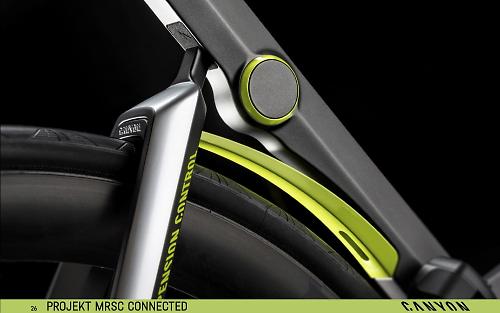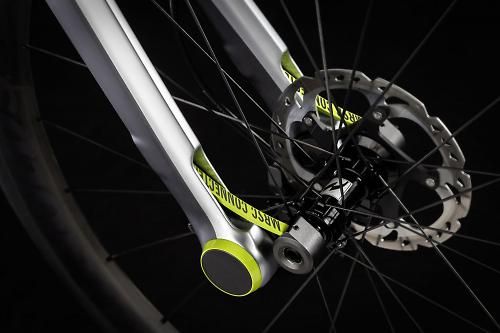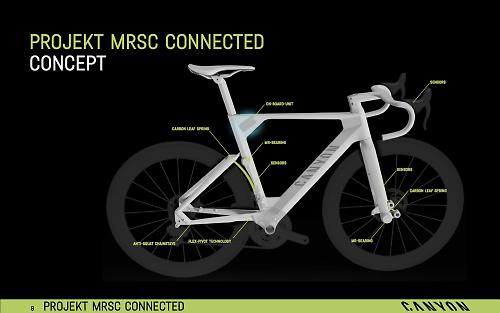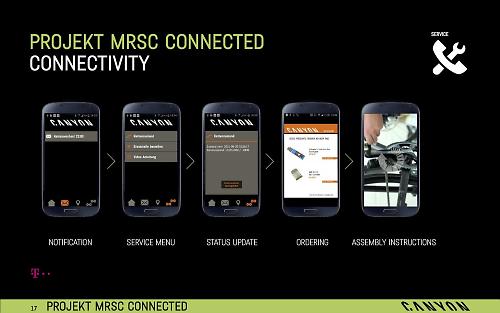- News
- Reviews
- Bikes
- Accessories
- Accessories - misc
- Computer mounts
- Bags
- Bar ends
- Bike bags & cases
- Bottle cages
- Bottles
- Cameras
- Car racks
- Child seats
- Computers
- Glasses
- GPS units
- Helmets
- Lights - front
- Lights - rear
- Lights - sets
- Locks
- Mirrors
- Mudguards
- Racks
- Pumps & CO2 inflators
- Puncture kits
- Reflectives
- Smart watches
- Stands and racks
- Trailers
- Clothing
- Components
- Bar tape & grips
- Bottom brackets
- Brake & gear cables
- Brake & STI levers
- Brake pads & spares
- Brakes
- Cassettes & freewheels
- Chains
- Chainsets & chainrings
- Derailleurs - front
- Derailleurs - rear
- Forks
- Gear levers & shifters
- Groupsets
- Handlebars & extensions
- Headsets
- Hubs
- Inner tubes
- Pedals
- Quick releases & skewers
- Saddles
- Seatposts
- Stems
- Wheels
- Tyres
- Health, fitness and nutrition
- Tools and workshop
- Miscellaneous
- Buyers Guides
- Features
- Forum
- Recommends
- Podcast
Video: Canyon's full-suspension, cloud connected MRSC concept
We’re used to seeing concept bikes at the big shows. Most often they’re very shiny and everyone crowds around them, and then they disappear without a trace. Canyon don’t seem to do it that way, though: their urban bike, which was a concept last year, is now in production looking pretty much the same. So when they show us a full suspension, cloud-connected road bike, we’re going to assume that it’s more or less do-able. And it’s sporting some amazing tech.

It’s a full suspension platform. Obviously, we’re not talking about masses of travel but there’s a carbon leaf spring at each end; Canyon already use that tech in their VCLS seatpost.
The really clever bit is the bearing that acts as the pivot of both front and rear suspension. It's filled with a special fluid that changes viscosity when it’s subjected to a magnetic field, so the damping of the suspension can be altered electronically, all the way up to a full lockout. It’s called a magneto-rheological fluid, if you’re into that kind of thing. Canyon aren’t the first to think about using the technology: Fox have been playing about with it on their mountain bike suspension for a couple of years.

The idea here is that the suspension can respond to changes picked up by sensors on the bike. Thanks to sensors in the seat tube, the damping can be made to respond to changes in road condition, easing off on the damping when the surface is bad and firming up on good tarmac. On top of that, sensors on the contact points could also detect your position and adjust the damping accordingly. If your hands are on the drops, the bike can lock out the front and rear for a sprint.

That’s not the only new development on this concept bike. The MRSC also has an on-board unit that Canyon have developed in conjunction with Deutsche Telekom. It contains an industrial SIM card that allows the bike to connect to the cloud and perform a number of functions.
First up, the bike is GPS-enabled so you can track its rides. This is obviously something that many units can do already but the always-on MRSC will keep an accurate log of all the miles the bike has done, and could come in handy if your bike gets nicked: Canyon plan to build the on-board electronics into the frame so that they’re not removable without trashing the bike.

As well as that, Canyon have designed an app that syncs with the bike, and it’ll give you advice on the service life of the components. So it’ll ping you a message when the chain has done a certain number of miles, and suggest that you check it. If it needs changing, you’ll be able to order the chain directly from the app, and you’ll also be able to watch instructional videos on how to replace components.
The third function of the on-board unit is an emergency call system. If the accelerometers on the bike detect a serious crash, they’re able to put a call through to the emergency services using the on-board SIM, including precise location data from the GPS.
That’s a lot of tech shoehorned into one bike. Will we see it for sale next year? Probably not, no. There’s some questions that remain unanswered. Canyon want the bike’s on-board unit to charge itself, and right now they don’t have that sorted. The ideal scenario, they told us, would be that the power is generated by non-drivetrain forces. You could use micro-generators in the suspension or piezo elements in the frame, for example. That’s some way away from being workable at the moment, but as a concept it’s certainly an interesting indicator of the kinds of things bike companies are looking at.
Dave is a founding father of road.cc, having previously worked on Cycling Plus and What Mountain Bike magazines back in the day. He also writes about e-bikes for our sister publication ebiketips. He's won three mountain bike bog snorkelling World Championships, and races at the back of the third cats.
Latest Comments
- Slartibartfast 6 min 1 sec ago
What I find most amazing is that they didn't use this an opportunity to encourage drivers to check their vision and get an eye test. I was waiting...
- Simon E 37 min 25 sec ago
Three further incidents this week. What a bonanza!...
- slc 48 min ago
The Cugel I knew typically prevailed on others to prepare food. But I was always curious about the porridge of drist and raisins enjoyed on the...
- Freddy56 1 hour 33 min ago
"It'd appear the sportive organizer is particularly uncaring"...
- kingleo 1 hour 46 min ago
Cyclists have been riding in Bister for about 150 years, and now all of a sudden they are a great danger to pedestrians.
- the little onion 2 hours 13 min ago
I didn't remove the sound because I didn't think that it mattered - quite clearly the swearing was in reaction to an act of frankly horrid...
- Nigel_2003 3 hours 23 sec ago
Know how the limiter screws on your derailleur work and use the right ones to keep chain on a manageable cog at the back and/or chainring at the...
- Freddy56 3 hours 23 min ago
Story one: "Here is all the deals at 50% off."...
- andystow 3 hours 37 min ago
Front wheel trued and tensioned last night. I think it took me well over an hour.
- quiff 4 hours 4 sec ago
From the article above.













Add new comment
23 comments
Mmmmmm, comfy...
rsz_dscf0980.jpg
How much more "comfy" should bikes get when they are already quite "comfy"?
Point of the machine is workout. Bit of discomoft after 100 miles, if that, is normal.
Like it a lot but I prefer a steel Pelizzoli, thanks.
http://biketechreview.com/index.php/forum/1-general-discussion/26438-vib...
Some reading on efficiency of bikes with various amounts of 'suspension' on rougher roads. The simple idea is, if you're attached to a vibro-power type of device, how well do you think you could pedal? : )
If you're lucky enough to ride perfect Italian tarmac all day, ignore it. In the UK it's all become a bit different.
Is this an implicit acknowledgement that actually Vertical Compliance is, for the most part, bollocks and that if you need 'suspension effects' then you have to move the wheels more than a fraction of a mm or 2?
Sort of, maybe. Most of us will feel a difference between a brutally stiff bike and one with some general flex or less direct shock transmission but I think shock dissipation 'compliance' is micro stuff. Those who aren't riding 100psi 23-25C tyres as standard know that a bike can be fast as well as comfortable and tyres can make way more difference than frame designs. Stiff may help in a sprint or a snappy climb, it doesn't do much for your ability to keep a good pace up over say >7-8 hours on typical UK road surfaces.
I spent much of this last winter into spring on an aluminium framed, carbon forked road bike with some really light, high-volume tyres and wide rims on. 40psi tops. So far, suprisingly at first, it's the fastest bike over a gently rolling 100 mile route I ride quite often out of a number of road bikes, it's hard to be scientific about it but I know I feel fresher in the last 20-odd miles on it than many 'faster' looking bikes.
Anyway .. great to see things like this being investigated at Canyon. Maybe the conclusion will be, yes, suspension makes a dramatic difference - so how do we achieve it best; are bigger tyres the answer or are pivots, flex-zones etc the way forward?
A stiff, comfortable, full suspension bike with road-sport possibilities!
While that's all good, it's not exactly new... Moulton have been making them for decades.
Pipe dreams from fantasyland. More rigidity = more efficient. This is clearly geared more towards people who don't care/know about efficiency.
The on-board GPS is a good idea. The magnetic "locking" suspension... not so much. Even if the fluid were fully non-Newtonian, you'd never be able to get it firm enough for maximum efficiency and you'd always be flopping around on a fish of a bike.
Mercedes was one of the first to use magnetic controllers to alter ride quality. It *can* change from squidgy soft luxury mode to a snappier "sporty" feel, but unless you've got some really, really strong electromagnets (read: heavy + heavy power source), you're never going to get it firm enough unless you create an *actual* mechanical lockout in the valving. Back to square 1.
If the bike is squishy, it will always be squishy.
Also, 'piezo microgenerators'... lol. Looking for non-drivetrain forces. Unless there's something badly, badly wrong with the bike, there just isn't going to be enough energy coming out of it from non-drivetrain forces to charge much of anything. You'd get more power from sticking the wire leads into a lemon. Also, piezo would get its power form vibrations running through the frame... But suspension is designed to reduce those vibrations...
Concept problems everywhere. This is just marketing hype to give the impression that they are working at the forefront of the field.
And guess who got out of bed on the wrong side today ? Please cheer up, lifes too short to be Mr Grumpy
Please cheer up, lifes too short to be Mr Grumpy
As you clearly do, can you tell about how the front axle compliance here translates into drive inefficiency and what magnitude you might expect for that ? Presumably we could also stiffen up those shockingly inefficient tyres as well ?
if it's that simple, why are the pros switching to 25mm tyres? why are they riding domanes and roubaixs and defys and fenixes in top-tier races? why are they riding less stiff aero bikes on flat stages?
reducing cycling efficiency to a simple function of stiffness is nonsense. that's not to say this Canyon system is necessarily going to fly, or it's a good idea. but it's good to see people trying stuff, and canyon have as good a record at that as anyone recently
Connected to the cloud? What could possibly go wrong?
Nothing, as long as you're not Jennifer Lawrence.
It posts pictures online of you struggling up your local hill, gives up half the bike when it thinks you're only producing half of the expected wattage, never deletes anything thus providing a constant reminder of just HOW slow you are, charges you more money for riding more than x hours per month, and lets your boss see that you've been out cycling when you were supposed to be working from home. (Allegedly. Ahem.)
If your hands are on the drops, the bike can lock out the front and rear for a sprint.
Yup all the big sprinters are now using the on the hoods sprint position as demonstrated be no-one ever.
Aside from my assault on the phrasing, I do have to defend Canyon against some of the vitriol above; it's a concept bike, not a production one, despite Road.cc's assertion that previous Canyon concepts have made production.
Go look at the world of car concepts and the following production models, they poke pins into the future with outrageous ideas, some of which stick some of which disappear, but without pushing the envelope we're still riding the safety bicycle.
Whut?
And what vitriol? There are a couple of tongue in cheek comments up there but unless I'm missing something?
I would suggest that it is an honest approach to suspending a road bike, unlike Trek/Specialised where it working depends on your weight...
I really like this work from Canyon, but I think calling IsoSpeed dishonest is a bit harsh.
Wow, it's great to seem a firm doing something genuinely new. Well done Canyon
All these modifications seems entirely unnecessary and only seem to detract from the spiritul essence of cycling. I worry that this relentless march of technological 'progress' will destroy the simple, beautiful, primeval symbiosis that is found when man and bicycle meet.
I want one.
That's some clever stuff, although it seems odd that no head unit appears to be included. All this other tech, and you still end up fitting a bog-standard aftermarket cycle computer?
So that's Magneto handling the suspension, Charles Xavier handling the almost telepathic 'sense the road' sensors, and then to top it all off, Neo as you plug into the always on Matrix.
Excellent...as long as you keep track of solar flares and EMP drone strikes.
This really needs a HUD and a voice too, like KITT, and turbo boosters.
I think I'll spare myself the humiliation, when It realizes I'm not fast enough and orders a new rider